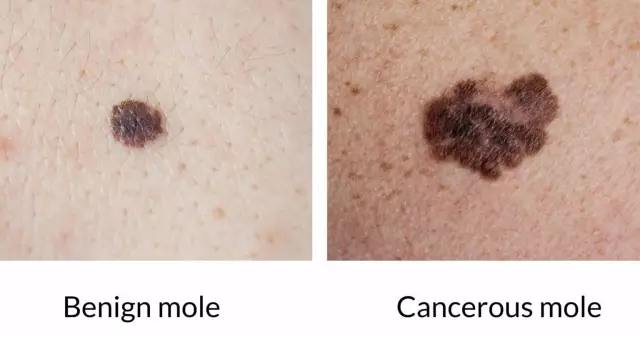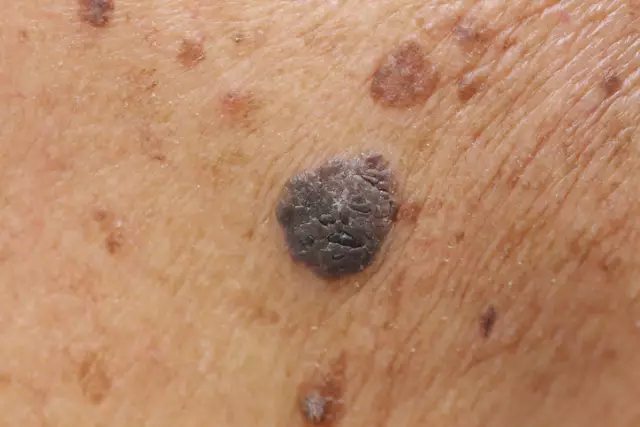- Author Rachel Wainwright [email protected].
- Public 2023-12-15 07:39.
- Last modified 2025-11-02 20:14.
Dangerous mole - symptoms

A mole can be a zest, a piquant feature on the human body. But, along with this, it can pose a serious danger to humans. Today, a rather urgent problem is the degeneration of moles into melanoma. Doctors-dermatologists remind people of this problem and ask them to pay more attention to it.
The rapidly increasing number of melanomas is associated primarily with environmental degradation. It is good that modern medicine also does not stand still and today has quite wide opportunities to diagnose in time the degeneration of an ordinary mole into a dangerous one, and to save a person from this problem.
However, the statistics are daunting. In post-Soviet countries, melanoma is fatal in about 95% of cases. Whereas in America and Europe about 5% die of melanomas, and 95% are cured.
The mystery of such a high mortality rate lies in the late diagnosis of this disease among residents of the post-Soviet space. People are used to paying little attention to themselves, so they ignore dangerous symptoms and often go to the doctor when it's too late to help. As a result, already late stages of the disease with numerous metastases are often diagnosed. And this, you see, does not facilitate treatment.
If at the initial stage a dangerous mole (melanoma) can be simply removed (there are many ways for this - laser and radio wave method, evaporation, surgery), then at the last stage it is no longer possible to simply get rid of a malignant formation without negative consequences for the body.
How to identify a hazard?
There are many moles on our body. Some have dozens of them, and some have hundreds. They are all of different shapes and sizes: flat, convex, light and dark, small and large. This is the norm. The number of moles on the human body largely depends on heredity. Very often, children can see the largest and most prominent moles in the same place as their parents. On the body of an adult, on average, you can count about fifty moles, but this number is very arbitrary. Therefore, if you have more of them on your body, do not sound the alarm. You just need to follow the dynamics of their development. It is also worth noticing every new mole that appears on your body.
You should know that in most cases, the appearance of new moles, especially dangerous ones, is promoted by too frequent exposure to the sun and sunburn.
If you have a lot of moles, don't spend too much time in the sun. Also refrain from visiting the solarium. Believe me, a beautiful chocolate skin tone is incomparable with the possible risk of melanoma. Before going to any sunny resort, it will not be superfluous to consult with a dermatologist regarding the permissibility of natural and artificial radiation.
The biggest danger is posed by large moles with a diameter of more than five centimeters. Particular attention should be paid to those moles that are present on our body not from childhood, but, for example, appeared after another vacation on the sea beach. It happens that melanoma also occurs through a small mole, about 1-2 millimeters. But those moles from which a hair grows are considered absolutely safe.

Rule "ACORD"
Here are the nuances that you should pay attention to first of all when checking for a mole:
- A (asymmetry). A normal mole should be symmetrical. If you conditionally divide the mole with a vertical or horizontal axis and at the same time you get two unequal halves, that is, a reason to visit a dermatologist.
- K (edge). A normal birthmark should have smooth edges, without irregularities and jags.
- O (color). It should be uniform and uniform. It is worth visiting a dermatologist if the mole is black or red, there are various streaks and blotches on it, any shades.
- P (size). Larger moles are therefore more dangerous. It is also worth monitoring the change in size of moles. If a mole grows quickly, it is a sign of potential danger. It is also dangerous when the general area of the body is covered with a large number of moles.
- D (dynamics). Moles on the body can appear and disappear throughout life, this is considered natural. However, it is worth paying attention to the rapidity of the appearance and growth of a mole. If, in your opinion, this happens very quickly, it is worth seeing a dermatologist, especially if the growth is accompanied by the following symptoms: scratching, peeling and bleeding.
If you notice at least one of the above symptoms, it is worth taking some free time and visiting a dermatologist. Please note that malignant neoplasms in moles develop so rapidly that in this case it is absolutely stupid to risk your own health. Removing a dangerous mole, diagnosed in a timely manner, is a fairly accessible and simple process, in most cases without negative consequences.
Found a mistake in the text? Select it and press Ctrl + Enter.






